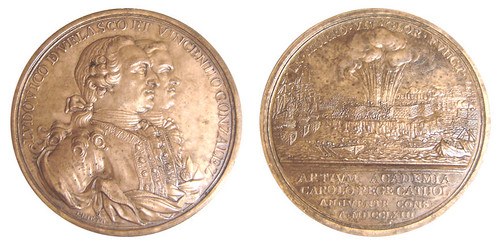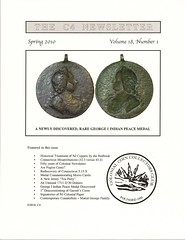
PREV ARTICLE
NEXT ARTICLE
FULL ISSUE
PREV FULL ISSUE
THE SPRING 2010 C4 NEWSLETTER PUBLISHED
I recently received my Spring 2010 issue of the C4 Newsletter, a publication of the Colonial Coin Collectors Club. At my request editor Syd Martin forwarded the table of contents and some text and images for inclusion here in The E-Sylum.
-Editor
Franklin L. Noel's article on the Fugio coppers is a response to Eric Newman's recent book. He writes: Fugios are cents. They always have been. They always will be. That's my story and I'm stickin' to it! In his recent book, United States Fugio Copper Coinage of 1787, Eric Newman suggests we adopt a new nomenclature for the Fugio coins. I respectfully disagree. Because the Continental Congress clearly intended the Fugio coins to be cents, we should continue to call them cents. Congress required the contractor to strike the coins to “the federal standard.” Under the federal standard, 100 cents should contain 2.25 pounds of copper (157.5 grains per cent). The nominal value of the Fugio coins, as authorized by Congress, was one cent. What makes these coins cents is the requirement that they be struck to the “federal standard.” The failure of Congress to require that the coin's name be included in the devices (as Massachusetts had done) does not make the Fugio coin a “denomination-less copper.” The only copper coins the Continental Congress ever authorized (in its August 8, 1786 Resolution) were cents and half cents. Jarvis' Fugio coins were to be struck to this “federal standard.” As the federal standard required that 100 cents consist of 2 1/4 pounds of copper, by legal definition, the coins Congress ordered Jarvis to strike were “cents.” An article of interest to bibliophiles is James Higby's The Evolution of Redbook Listings for New Jersey State Coppers. How to collect colonials was a question that came up again and again. As do so many of us, I scurried to the Redbook, intent upon learning everything I could about the material in that section that had been neglected for so long. There I found a somewhat methodical taxonomy and presentation that seemed understandable and workable. I use the term “somewhat” because I found some issues that could not be resolved in the light of information contained in other publications or, in a few cases, reality itself. For example, the inclusion of a 1787 New Jersey “small planchet, plain shield” in the Redbook listings resulted in the frustration of being unable to find a truly plain shield anywhere, never mind the dozen or so slabs I had seen so labeled, but encapsulating coins that clearly showed a shield outline. The same could be said for listings for “wide shield” and “narrow shield” among the Jersey varieties. There were no specifications given for those terms, it seemed. A series of emails with Ray Williams and Will Nipper convinced me that such terms were arbitrary and that I should devise my own scheme for classifying and collecting these wonderful old New Jersey coppers. Still, one needs to have a jumping-off place, and that place for me will always be the Redbook. What I therefore propose to do in this article is to show how the listings for New Jersey coinage started out and then evolved through sixty-three more editions of that publication. After 64 editions of the Redbook, its New Jersey state coppers section now identifies 22 varieties. We have seen listings come and go and change. We might assume that the editors of each edition made their decisions based on a combination of collector interest, discoveries, scholarship, popularity, availability, and uniqueness. Marc Mayhugh's article on the Morro Castle medal describes an interesting piece with a connection to Cuba, something I hadn't expected to see.

An interesting specimen in the Betts series of medals illustrating American history is Betts 443, “Capture of the Morro Castle, Havana.” These medals are located in the chapter entitled “The Period of Intercolonial Wars,” and they are unusual in that they commemorate a gallant defeat rather than a victory, unlike most of the other medals in this section. In this case, the medals are Spanish, and memorialize the two courageous commanders of Havana who lost their lives in the defense of their post, Don Luis Vincente de Velasco and Vincentio Gonzales. The commission of the medals, albeit a year after the defeat, must have taken a great deal of resolve on the part of the Spanish King who would have rankled every time he thought of losing Havana to the British, Havana being the jewel of the Caribbean, and one of Spain's most valuable possessions. Late in the Seven Year's War, or as it was known in America, The French-Indian War, Spain became involved in a conflict which for the most part was over. The British had already expelled the French from America and had made significant gains elsewhere. The decision by the King of Spain, Charles III, normally considered a wise monarch, especially by Spanish standards, to side with France was to prove disastrous to Spanish New World holdings. Accounts of troop strength on both sides is also conflicting, but suffice it to say the British entered the harbor and began a lengthy siege of Morro Castle. Construction on Morro castle had begun in 1589, under the supervision of Bautista Antonelli and was finished in 1630. It served for years as a deterrent to pirates and enemy warships, yet the British attack in 1762 was not to be denied, despite horrendous losses in manpower. The siege which began in March decimated the British forces and by mid July eight thousand sailors and soldiers were suffering from various diseases and exposure to the Cuban heat. However, supplied by fresh troops from America8 and a contingent of slaves from Jamaica, the British were able to dig a mine beneath the walls of the fort and blast through them, storm the fort, and doom the defenders of Havana. Wayne Homren, Editor The Numismatic Bibliomania Society is a non-profit organization promoting numismatic literature. See our web site at coinbooks.org. To submit items for publication in The E-Sylum, write to the Editor at this address: whomren@gmail.com To subscribe go to: https://my.binhost.com/lists/listinfo/esylum All Rights Reserved. NBS Home Page Contact the NBS webmaster 
|
